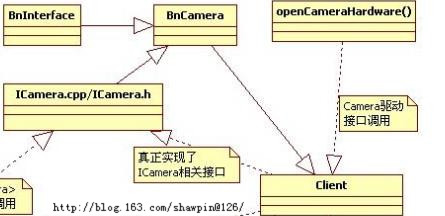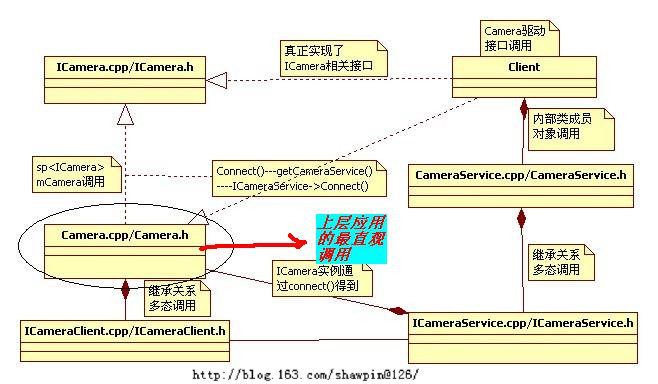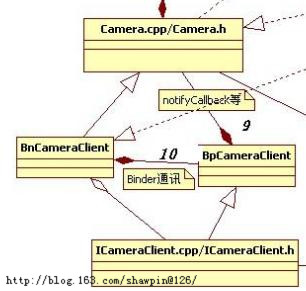7. 那么现在的关键就是 Client 类了·进一步跟进:
CameraService::Client::Client(const sp<CameraService>& cameraService,
const sp<ICameraClient>& cameraClient, pid_t clientPid)
{
…..
mCameraService = cameraService;
mCameraClient = cameraClient;
mClientPid = clientPid;
mHardware = openCameraHardware();
}
将 cameraService 和 cameraClient 的实例分别赋值给了 Client 的类成员变量。
另外 openCameraHardware() 是值得注意的地方,也就是连接上层应用和底层驱动的关键,通过调用 openCameraHardware() 得到了一个 CameraHardwareInterface 实例对象,并赋值给自己的类成员: `
sp<CameraHardwareInterface> mHardware;
对 hardware 的操作就是通过该对象完成的,所以说真正意义上的功能实现其实就是在这里,即 client 类的函数接口调用。
对于 hardware 的东东咱们暂时不去关注吧。
那么我们再次仔细研究下 Client 类的继承关系 ( 这些继承关系很容易混乱,涉及到较多的多态类型转换 ) ,这个其实往往都很关键:

Client 继承于 BnCamera ,而 BnCamera 则继承于 ICamera ,也就是说 Client 继承了 ICamera, 实现了 ICamera 中的函数。
进而发现,原来绕一个大圈,把最开始的图简化下:

8. 除此之外还有两个步骤或许需要去研究下:
先从单一函数去跟进,看具体一些 callback 的实现流程:
// callback from camera service
void Camera::notifyCallback(int32_t msgType, int32_t ext1, int32_t ext2)
{
sp<CameraListener> listener;
{
Mutex::Autolock _l(mLock);
listener = mListener;
}
if (listener != NULL) {
listener->notify(msgType, ext1, ext2);
}
}
这是 Camera 类中一个 callback 函数实现,但其本质在哪?先看 camera 类的继承关系:

通过以上的继承关系,继续跟进其父类 ICameraClient :
class ICameraClient: public IInterface
{
public:
DECLARE_META_INTERFACE(CameraClient);
virtual void notifyCallback(int32_t msgType, int32_t ext1, int32_t ext2) = 0;
virtual void dataCallback(int32_t msgType, const sp<IMemory>& data) = 0;
virtual void dataCallbackTimestamp(nsecs_t timestamp, int32_t msgType, const sp<IMemory>& data) = 0;
};
其中 notifyCallback() 又是纯虚函数 , 则同样说明实现在其子类 BpCameraClient 中:
// generic callback from camera service to app
void notifyCallback(int32_t msgType, int32_t ext1, int32_t ext2)
{
LOGV("notifyCallback");
Parcel data, reply;
data.writeInterfaceToken(ICameraClient::getInterfaceDescriptor());
data.writeInt32(msgType);
data.writeInt32(ext1);
data.writeInt32(ext2);
remote()->transact(NOTIFY_CALLBACK,data, &reply, IBinder::FLAG_ONEWAY);
}
然后通过 Binder 通讯调用到 BnCameraClient 中实现:
status_t BnCameraClient::onTransact(
uint32_t code, const Parcel& data, Parcel* reply, uint32_t flags)
{
switch(code) {
case NOTIFY_CALLBACK: {
LOGV("NOTIFY_CALLBACK");
CHECK_INTERFACE(ICameraClient, data, reply);
int32_t msgType = data.readInt32();
int32_t ext1 = data.readInt32();
int32_t ext2 = data.readInt32();
notifyCallback(msgType, ext1, ext2);
return NO_ERROR;
} break;
….
}
进而调用到了 Camera.cpp 中的函数实现了,但或许你有疑问,这些 callback 是涉及到一些驱动的 callback ,哪怎么跟驱动联系起来那?
结合之前对 hardware 接口调用的类 Client ,进一步可以发现 callback 的处理同样是在 Client 类实例化的时候:
CameraService::Client::Client(const sp<CameraService>& cameraService,
const sp<ICameraClient>& cameraClient, pid_t clientPid)
{
…..
mHardware->setCallbacks( notifyCallback ,
dataCallback,
dataCallbackTimestamp,
mCameraService.get());
…..
}
调用了 mHardware 将 callback 传入,但此处的 notifyCallback 并不是 camera.cpp 中的函数,而是 client 类的 notifyCallback 函数。
再继续看 client 类中的 notifyCallback 函数实现:
void CameraService::Client::notifyCallback(int32_t msgType, int32_t ext1,int32_t ext2, void* user)
{
…..
default:
sp<ICameraClient> c = client->mCameraClient;
if (c != NULL) {
c->notifyCallback(msgType, ext1, ext2);
}
break;
…..
}
通过得到 ICameraClient 实例进而调用到了具体的对象 Camera 的 notifyCallback() 函数。这个地方估计会遇见跟 ICameraService 函数调用一样的问题, ICameraClient 函数调用所需要的函数实例在哪?
记得上述 ICameraService 讲到的 connect() 函数嘛?其中有一个参数不能被忽略掉的,就是 ICameraClient ,但它在真正传入的时候却是一个 ICameraClient 子类 camera 的实例对象。
CameraService:
sp<ICamera> CameraService::connect(const sp<ICameraClient>& cameraClient)
{
…..
// create a new Client object
client = new Client(this, cameraClient , callingPid);
…..
}
Client:
CameraService::Client::Client(const sp<CameraService>& cameraService,
const sp<ICameraClient>& cameraClient , pid_t clientPid)
{
….
mCameraService = cameraService;
mCameraClient = cameraClient ;
….
}
这样就清楚了,其实 Client 在调用设置 callback 的调用最终还是调用到了 camera.cpp 中的 callback 函数,进而将具体内容通过 callback 反馈给上层应用做出相应的处理。






















 948
948

 被折叠的 条评论
为什么被折叠?
被折叠的 条评论
为什么被折叠?








